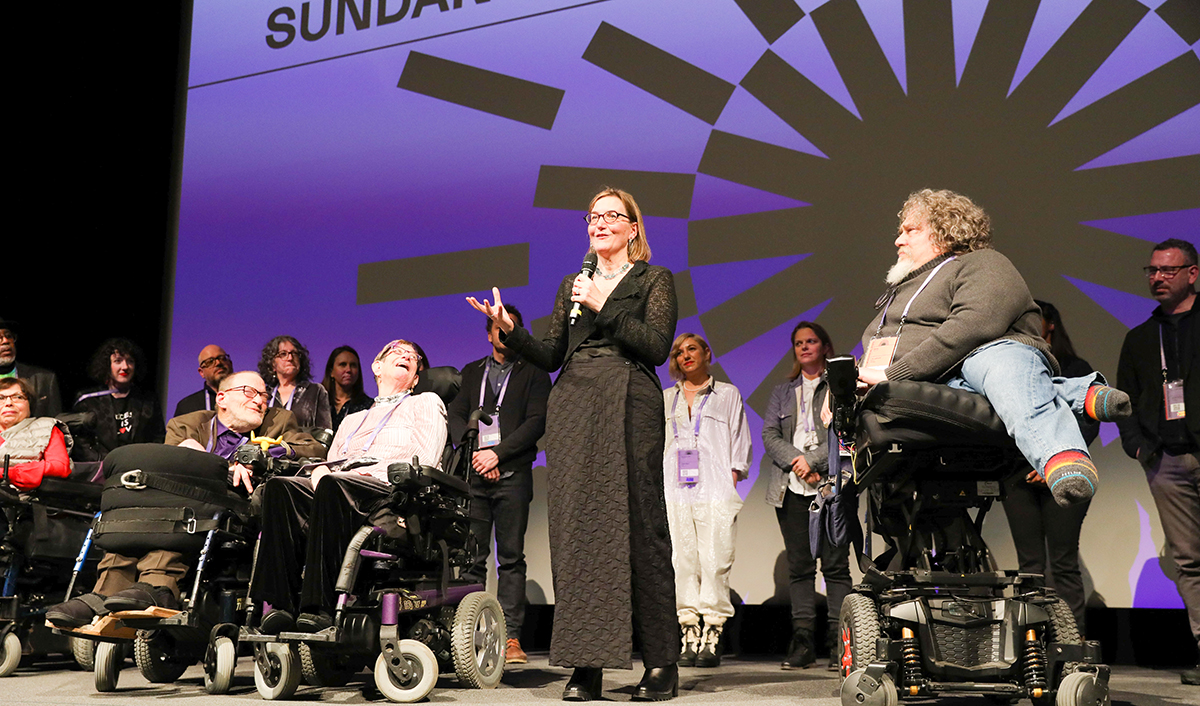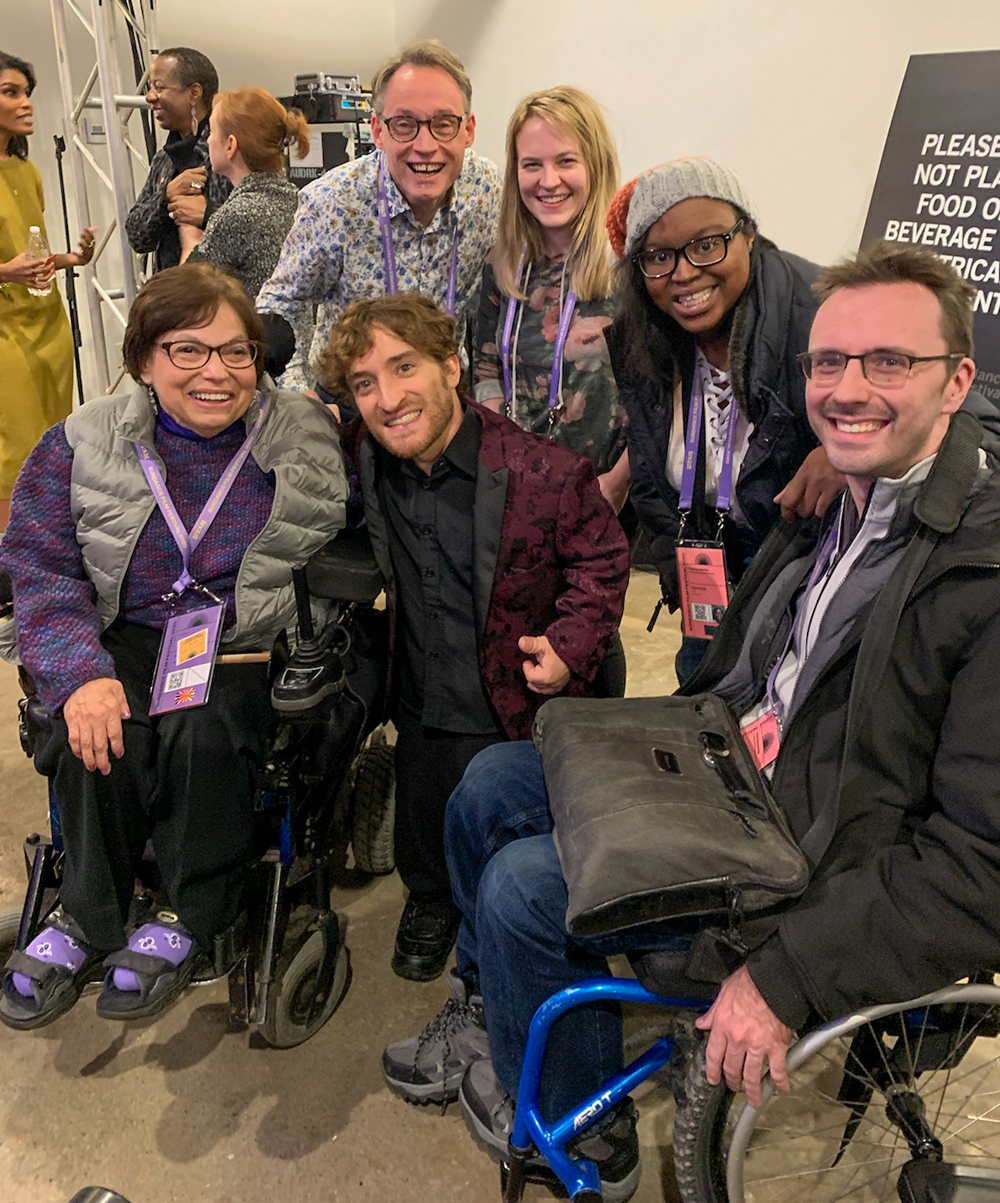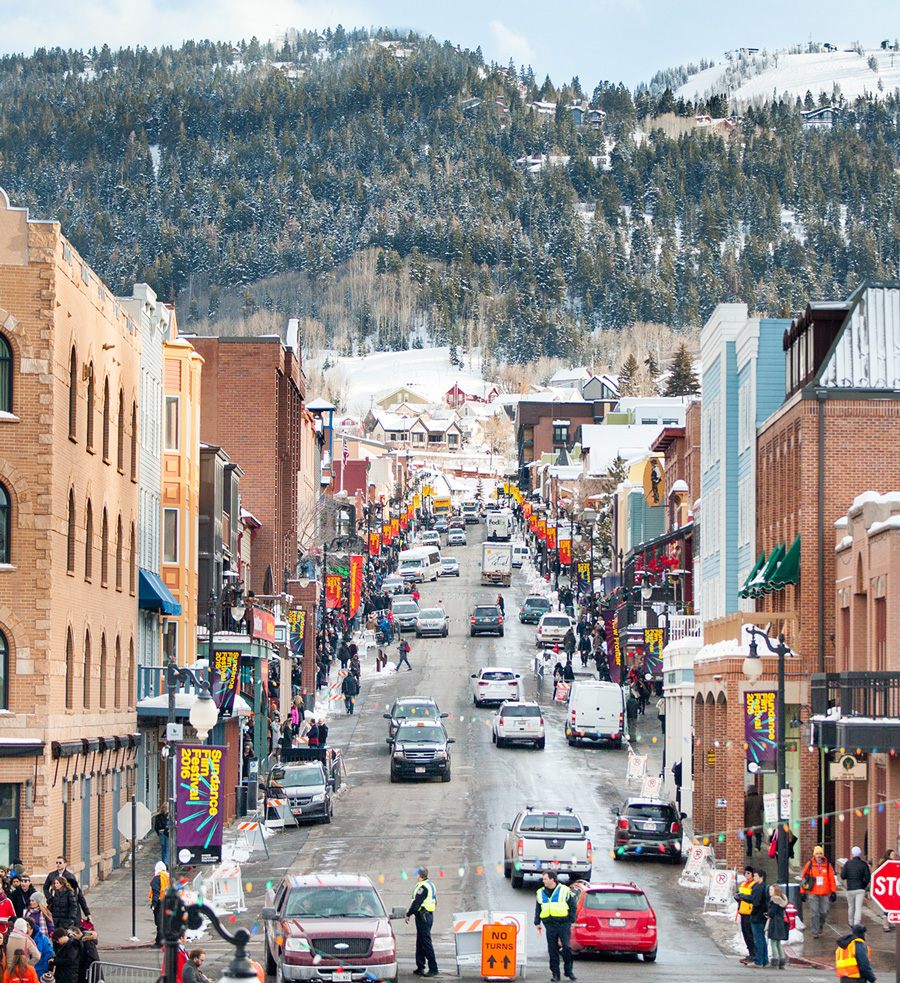
The cast and crew of Crip Camp take the stage at the Sundance Film Festival. That’s co-director Nicole Newnham holding the mic. Photo courtesy of Sundance Institute.
It’s no secret most paid film journalists tend to be of the white, straight, male and nondisabled varieties. This year, however, the Sundance Film Festival’s new Press Inclusion Initiative offered stipends to help load Park City, Utah, with journalists that looked and lived a bit more like the diverse filmmakers, characters and documentary subjects they’d be covering.
According to the Sundance Institute, 317 journalists and freelancers applied for this inaugural stipend program, and 14% of those applicants were people with disabilities. Among the 51 writers approved for stipends, 25% identify as disabled.
I was among that 25%.
“I hate to tell you,” a Sundance-savvy friend of mine wrote me shortly before my Utah trip, “but it will be a be a bit of a challenge to get around town. Main Street is at the top of a steep hill, and that’s where most of the receptions and parties are.”
Oh, boy.
“Main Street is at a little bit of an incline,” wrote another friend, “which may be an issue in either your wheelchair or on your crutches, especially if it all ices over.”
Of her own volition, my step-grandma in Omaha began researching Park City, even calling her own sister who lives near the area. A wheelchair-using friend of mine loaned me new (and thicker) tires. Crutch tips capable of cutting through ice suddenly appeared in my mailbox.
And I bought myself a new and probably unnecessarily large winter coat, only because it felt like, well, I should do something. A world of other people’s concerns had managed to burrow its way into my head: Was I visiting a film festival or summiting Mount Kilimanjaro?
My first night in Park City left me wondering, with some amusement, if all that commotion had been necessary. The rideshare from the Salt Lake City airport to the Rey Theater in Park City was easy enough. The already-fallen snow seemed more picturesque than menacing, and I arrived at my destination with plenty of time before the world premiere of Crip Camp lit up two simulcast screens.

Judy Heumann, Nic Novicki, Lawrence Carter-Long, Dr. Laura Dorwart, Keah Brown, and David Radcliff at Sundance. Photo by Kata Galasi.
That documentary film — with its powerful story of disabled people forming friendships, sharing grievances and then turning their relationships into a platform for advocacy — reminded me that routinely proving our own capacity for ingenuity and survival is simply a function of disabled life.
But that same night, the film also reminded me of the importance of community. After all, the fact that so many people wanted me to have a great and safe time at Sundance is just as meaningful to me as making it understood I can create such an experience without risk to myself.
So, let me pause here to recognize that I did have a great time at Sundance. In fact, as I think back to the four days I spent in Park City, my thoughts are filled not with the topographic challenges I expected to encounter, and not even with the stories of personal triumph I’d perhaps expected to write about here.
Instead, what I remember are the days spent surrounded by friends, many of whom are themselves disabled, and many of whom benefited from the same press stipend program that had brought me to the festival. In few other places would our voices be collected and amplified for the benefit of an industry. All too often — on-screen and behind the scenes — we are left somewhere in the margins if we’re anywhere at all.
Meaningful Moments
Thanks to Sundance, I met voices and writers from the disability community whom I’d long admired only through Twitter. I partied with disability-rights activist Judy Heumann, herself a central figure in Crip Camp. I conspired with Lawrence Carter-Long of the Disability Rights Education and Defense Fund. I unexpectedly ran into a nondisabled friend from Chicago while inching my way down the (yes, very steep) slope of Main Street, then bumped into another friend from Austin, Texas.
I wheeled past the snowbanks in Park City alongside Nic Novicki and Teale Sperling, two friends who are little people — each of us realizing how nice it was that none of us had to crane our necks to talk as we pressed forward.
For me, Sundance 2020 provided a well of small but meaningful moments like these. But it was also a reminder of my own privilege — my own ability to speak and to hear and to see. It was a reminder that there is still a lot of work to be done, at this festival and elsewhere, to make these spaces truly equitable and inclusive. And while there are several events I was able to attend, there were several others I avoided simply because of clear access oversights.
We all know the kinds of events I mean: mixers held at the top of two flights of stairs. Press screenings or parties situated in the middle of a hill. Industry conversations without a curb cut in sight.
And the irony of Sundance’s “Equality Lounge” — an ongoing salon highlighting issues of inequity across race, gender and disability — being at the summit of that infamously treacherous Main Street should, hopefully, be lost on no one.
The truth is stark: Many of the fights highlighted in Crip Camp — struggles for true access and inclusion and visibility — are still being fought today and sometimes even in spaces that may be, in all other ways, well-intentioned and thoughtful.
Perhaps nowhere was this reality more clearly underscored than in a morning screening of Crip Camp, at which the theater’s CaptiView, a portable viewing system used by Deaf patrons, malfunctioned. This technological failure was a moment of heartbreak for Michael McNeely, a Deaf-blind law student and film critic who attended the festival with a passion for Crip Camp’s story of disability rights. In his opinion, the CaptiView system, which is vulnerable to interference from cell phones and other technological devices, is a poor substitute for a much more inclusive option in a theatrical setting: open captions.
The simple choice to open-caption a film, McNeely later wrote, can help “ensure the needs of the few are balanced with the pleasure of the many.” In fact, the value of its inclusion was later made evident during Sundance’s industry panels, as it allowed McNeely and other Deaf visitors not only to follow robust conversations with ease but also to enthusiastically add their own voices to later Q&As.
Keah Brown, an accomplished disability advocate with cerebral palsy and the author of The Pretty One, had similar feelings of ambivalence about her Sundance experience. As she doesn’t use mobility aids, Brown knew Park City would likely present her with some “pretty rough” ambulatory challenges but was heartened that Sundance liaisons were “so wonderful and helpful” in fielding her questions prior to her visit.
What Brown wasn’t prepared for, she admits, was the mood of indifference she encountered from some Sundance volunteers once she was in the thick of the festival action. “It had always been a dream of mine to go to a film festival,” Brown admits, “and the movies and the panels were the aspects I thoroughly enjoyed. But there was such a disconnect between the people I’d been talking with [before the festival] and the people on the ground.”
Inconsistent Access
While Brown hoped there’d be options available to help transport her up and down the steep Main Street artery that cuts through the festival, she instead found herself endlessly sinking money into rideshares just to keep her body from collapsing — all because the free Sundance shuttles that were available would drop her only at the bottom of the hill.
“I walked up and down Main Street that first night,” she remembers, “and I thought, there’s no way I can do this for four days. Eventually, I was telling the rideshare drivers, ‘I’m desperate. Please just drop me as close as possible.’ It was just frustrating that there didn’t seem to be a true disability plan in place once we got to the festival. The stipend is wonderful, but what is being done for people once the festival is going on?”
Mel Addington, a film festival programmer who attended Sundance prior to acquiring multiple sclerosis three years ago, echoed similar concerns this year.
“The pre-festival team was super-nice and communicative,” Addington said. “I can’t stand for long periods, but they said, ‘Just let people know you’ve requested in advance to sit in the lobby.’ But the people at the venue weren’t reading the notes that were given to them. I felt like I had to explain my life history 50 times.”
Addington also noted a friend of hers who is a wheelchair user couldn’t enter a tent for press and industry screenings because the entryway was too narrow — a fact that was, unfortunately, only discovered at the moment of their arrival.
“It was like every day the rules changed,” Addington said, “and some of the volunteers were great, but others always wanted to make sure I understood how accessible they were being to me.”
Nevertheless, Addington, Brown, and McNeely all indicated willingness to return to Sundance in the future, perhaps to help keep this world-renowned festival progressing toward a truly equitable experience.
“[As a festival organizer], I know Sundance is trying really hard to get a lot of things right,” Addington said. “Often if you’re running an event like this, you’re not even thinking enough about these [disability equity] issues, which sucks because that’s such a big part of the population that you’re leaving out. It’s so important.”
** This post was originally published on https://www.newmobility.com/2020/03/behind-the-scenes-at-sundance/


